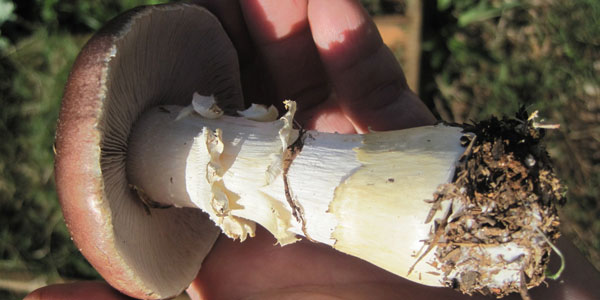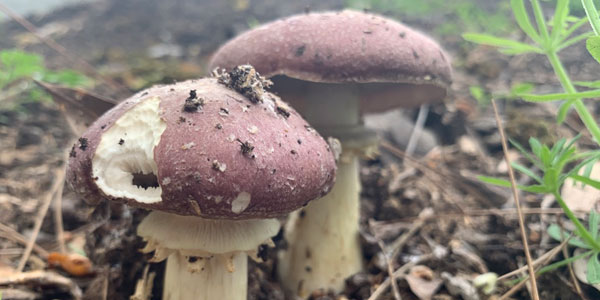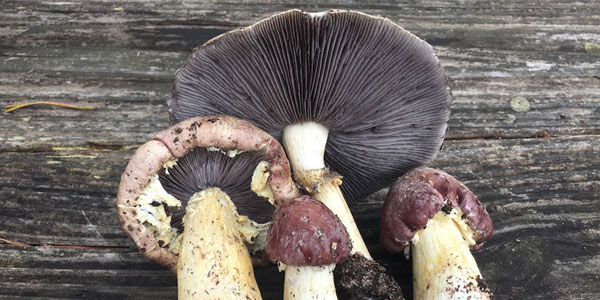Garden Giant / Wine Cap / King Stropharia - (Stropharia rugosoannulata)





ABOUT • FEATURES • LOOK-ALIKES • PROFILE • NUTRITION • MEDICINE • HELPFUL LINKS • RECIPE • MYCOREMEDIATION

Fun Fact:
A Living Mulch – Instead of traditional mulch, you can use King Stropharia spawn in wood chips, creating a living, nutrient-recycling system that feeds your plants.
I MAKE SOIL
Organic Matter Decomposition: King Stropharia breaks down complex organic materials, such as wood chips and straw, turning them into simpler forms that plants can more easily absorb. King Stropharia contributes to soil formation through the decomposition of organic matter.
I BIND SOIL
Soil Structure Enhancement: The mycelial networks of King Stropharia can help bind soil particles together, improving soil structure and aeration, which is beneficial for root growth and soil microorganisms.
I KEEP THE SOIL IN PLACE
Soil Erosion Prevention: This can be particularly effective in preventing soil erosion, as the interconnected mycelial strands reduce the impact of wind and water on the soil surface. By preventing erosion, King Stropharia can help maintain soil integrity and prevent the loss of valuable topsoil.
WITH ME AROUND, YOU DON’T NEED TO WATER AS MUCH
Water Retention: Mycelium acts like a sponge – The extensive network of mycelium in the soil absorbs and holds moisture, preventing water from evaporating too quickly. This helps keep the soil damp for longer, reducing the need for frequent watering.
I FEED AND FERTILIZE YOUR PLANTS
Nutrient Cycling: King stropharia plays a role in nutrient cycling, converting dead organic matter into nutrients such as nitrogen, phosphorus, and potassium, which are essential for plant growth.
I CLEAN YOUR SOIL
Soil Remediation: King Stropharia has been shown to absorb and break down pollutants and toxins in the soil: pesticides and herbicides, making it useful for cleaning contaminated lands. King stropharia also helps with suppressing pathogenic bacteria like E.Coli in the soil
I HELP AERATE YOUR SOIL
Sweet, Nutritious Mycelium = Worm Buffet: King Stropharia produces a sweet-smelling mycelium that attracts earthworms. The mycelium is packed with sugars, proteins, and beneficial microbes, making it an irresistible food source for worms.
Features

Cap
Large, broad cap (4–12 inches) that starts wine-red to reddish-brown and fades to yellowish-tan, with a smooth, slightly sticky texture when moist, drying to a matte finish.

Fertile Surface
Dark purplish-brown sporeprint.

Stipe
White to light tan. Thick and sturdy, often 4 to 8 inches (10-20 cm) long. Features a distinctive thick, ridged ring (annulus) near the top, which is a key identifier.
Look-alikes

Cortinarius spp.
Many Cortinarius species have rusty brown to orange spore prints, while King Stropharia has a dark purple-brown spore print. They often have a cobweb-like veil (cortina) instead of a thick, ridged ring on the stem. Some Cortinarius species are toxic, so proper identification is crucial!

Agaricus spp.
Agaricus mushrooms usually have chocolate-brown spore prints rather than purplish-brown. They lack the distinctive ring with ridges that King Stropharia has. Many Agaricus species have a strong anise or almond odor, unlike the earthy smell of King Stropharia.

Pholiota spp.
Many Pholiota species have yellowish to rusty-brown spore prints instead of purple-brown. Their caps are often scaly rather than smooth. They tend to grow on dead wood rather than wood chips and garden mulch.

Hypholoma spp.
Hypholoma species have yellowish-green to dark brown spore prints. Their gills are often yellow, greenish, or gray when young instead of pale gray. Some species, like Hypholoma fasciculare (Sulfur Tuft), are bitter-tasting and mildly toxic.
profile
| Edibility & Taste | Savory, almost like potatoes but with an Asparagus texture |
| Grows On | Hardwood mulch outdoors, pasteurized straw indoors |
| Fruiting Temps | 55-70F, Spring and Fall |
| Availability | Year-round |
Nutritional Benefits

Nutritional content of 1 cup (86 grams)
• Calories: ~30–40 kcal
• Protein: ~3–4g
• Carbohydrates: ~6–7g
• Dietary Fiber: ~2g
• Fat: ~0.5g
Medicinal Benefits

High in:
• B Vitamins (B1, B2, B3, B5, B9) – Support energy metabolism and brain function.
• Vitamin D (if exposed to sunlight or UV light) – Supports bone health and immune function.
• Potassium – Helps regulate blood pressure and muscle function.
• Phosphorus – Essential for bones and energy production.
• Iron – Supports red blood cell production.
• Magnesium – Helps with nerve and muscle function.
Helpful Links
📘 Blogs & Guides
🛒 Shop Spawn
🌟 Additional Resources
Recipe
Garlic Butter Wine Cap Mushrooms with Herbs
• 2 cups fresh King Stropharia mushrooms (sliced)
• 2 tbsp butter (or olive oil for vegan option)
• 3 cloves garlic (minced)
• 1 tsp fresh thyme (or ½ tsp dried)
• 1 tsp fresh rosemary (chopped)
• ½ tsp salt (or to taste)
• ½ tsp black pepper
• ¼ tsp red pepper flakes (optional for heat)
• ¼ cup dry white wine (or vegetable broth)
• 1 tbsp lemon juice
• 2 tbsp fresh parsley (chopped, for garnish)

• Clean the mushrooms: Gently wipe off any dirt with a damp cloth or brush. Slice into even pieces.
• In a large skillet over medium heat, melt the butter, then add the garlic and cook for about 30 seconds until fragrant.
• Add the sliced King Stropharia mushrooms, stirring occasionally. Cook for 5-7 minutes until they release their moisture and start to brown.
• Sprinkle in the thyme, rosemary, salt, and pepper. Pour in the white wine (or broth) and let it cook down for another 2-3 minutes until the liquid reduces.
• Finish with lemon juice & garnish: Stir in the lemon juice and remove from heat. Sprinkle with fresh parsley.
• Serve hot as a side dish, over pasta, on toast, or alongside grilled meats.
Storage: Leftovers keep well in the fridge for up to 3 days.
Mycoremediation Potential

Pathogen Reduction in Soil & Water
Breaks down harmful bacteria like E. coli and Salmonella, making it useful for agricultural runoff treatment and improving soil safety for crops. Filters contaminants in water systems, helping to reduce bacterial loads in polluted waterways.Heavy Metal Absorption
Research suggests King Stropharia can accumulate and bind heavy metals like lead (Pb), cadmium (Cd), and arsenic (As), reducing their mobility in the soil. This makes it a potential bioremediation tool for contaminated urban soils or post-industrial sites.Decomposing Hydrocarbons (Oil & Pesticide Breakdown)
Capable of breaking down hydrocarbons, meaning it may help degrade pesticides, herbicides, and petroleum-based pollutants in soil. Useful for restoring garden soils that have been exposed to chemical fertilizers or pesticides.Soil Regeneration & Carbon Sequestration
By breaking down wood chips and organic matter, it enhances soil structure and locks carbon into the soil, promoting long-term sustainability. Encourages beneficial microbial communities that further aid in decomposition and soil detoxification.Potential Applications:
✔ Agriculture: Reducing pathogens in manure-amended soils. ✔ Urban Gardens: Cleaning up soil contamination in community gardens. ✔ Waterways & Wetlands: Filtering bacteria and organic pollutants in stormwater runoff. ✔ Forestry & Land Restoration: Enhancing degraded landscapes with nutrient-rich fungal networks.
